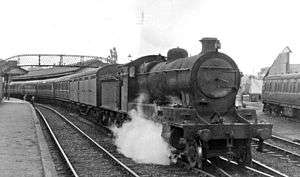Highland Railway Clan Goods Class
The Highland Railway's Clan Goods class was a class of steam locomotive. They were designed by Christopher Cumming. The first four (Nos 75 to 78) were built by Hawthorn Leslie and Company on Tyneside, and the maker's plates bore the date 1917, but because of wartime delays were not delivered until 1918.[1] Four more (Nos. 79 to 82) were built in 1919, also by Hawthorn Leslie.[2]
| Highland Railway ‘Clan Goods’ | |||||||||||||||||||||||||||||||||||
|---|---|---|---|---|---|---|---|---|---|---|---|---|---|---|---|---|---|---|---|---|---|---|---|---|---|---|---|---|---|---|---|---|---|---|---|
 ‘Clan Goods’ on an Aberdeen to Inverness express in 1948 | |||||||||||||||||||||||||||||||||||
| |||||||||||||||||||||||||||||||||||
| |||||||||||||||||||||||||||||||||||
| |||||||||||||||||||||||||||||||||||
| |||||||||||||||||||||||||||||||||||
Dimensions
They featured two Robinson type 20 1⁄2 by 26 in (521 by 660 mm) cylinders outside (with long tail-rods), 5 ft 3 in (1.6 m) driving wheel and a boiler set at 175 lbf/in2 (1.21 MPa). Locomotive weight was 56 long tons 9 cwt (126,400 lb or 57.4 t).
Transfer to LMS
All eight entered service with the London, Midland and Scottish Railway (LMS) in January 1923. They were classified '5F' by the LMS.
Transfer to BR
Six locomotives survived to enter British Railways (BR) service in 1948, of which five were given BR numbers.[3]
Numbering
| HR No. | Built | LMS No. | BR No. | Withdrawn | Notes |
|---|---|---|---|---|---|
| 75 | 1918 | 17950 | 57950 | August 1950 | |
| 76 | 1918 | 17951 | 57951 | May 1951 | |
| 77 | 1918 | 17952 | — | October 1946 | |
| 78 | 1918 | 17953 | 57953 | October 1948 | Withdrawn before BR number applied |
| 79 | 1918 | 17954 | 57954 | October 1952 | |
| 80 | 1919 | 17955 | 57955 | June 1952 | |
| 81 | 1919 | 17956 | 57956 | May 1952 | |
| 82 | 1919 | 17957 | — | March 1946 |
References
- Cormack & Stevenson 1990, pp. 117, 128.
- Cormack & Stevenson 1990, pp. 119, 128.
- Cormack & Stevenson 1990, p. 120.
- Baxter 1984, p. 202.
- Baxter, Bertram (1984). Baxter, David (ed.). British Locomotive Catalogue 1825–1923, Volume 4: Scottish and remaining English Companies in the LMS Group. Ashbourne, Derbyshire: Moorland Publishing Company. p. 202.
- Casserley, H. C. & Johnston, Stuart W. (1974) [1966]. Locomotives at the Grouping 3: London, Midland and Scottish Railway. Shepperton, Surrey: Ian Allan. p. 184. ISBN 0-7110-0554-0.
- Cormack, J.R.H.; Stevenson, J.L. (1990). Greenwood, William (ed.). Highland Railway Locomotives Book 2: The Drummond, Smith & Cumming Classes. Locomotives of the LMS. Lincoln: RCTS. ISBN 0-901115-72-X.CS1 maint: ref=harv (link)